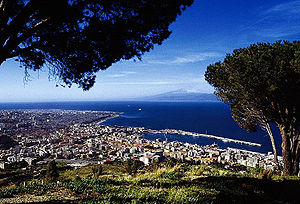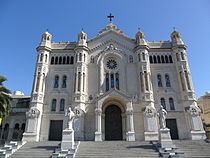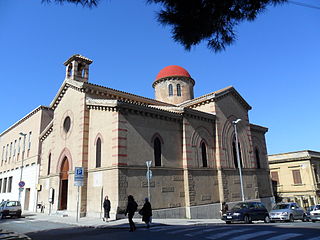 | ||
| Reggio di Calabria, Reggio Calabria, Greek Ῥήγιον, Latin. Rhegium | ||
| province | Reggio Calabria (RC) | |
|---|---|---|
| Residents | 181.447 (2018) | |
| height | 31 m | |
| no tourist info on Wikidata: | ||
| location | ||
| ||
Reggio di Calabria is a city in the south of Calabria, it lies at the "toe of your boot" on the "Stretto", the strait between Calabria and Sicily.
background
The city at the tip of the "boot" of the Italian peninsula is the most populous city in Calabria and was the capital of Calabria until the early 1970s. Due to the development into a stronghold of organized crime, the capital was dignified around 1970 from Reggio di Calabria to that which is only about half as large further north in the hinterland Catanzaro given up, the city remained the seat of the regional parliament and an important economic and commercial center.
The city is located in a trough-shaped slope of the Aspromonte on the coast of the Strait of Messina, the Stretto, which separates Sicily and Calabria (and was probably described in Homer's Odyssey as a strait between Scilla and Charybdis (on the Sicilian side).

history

As one of the first colonies on the Italian peninsula (next to Cuma) was in the area of Reggio around 730/20 BC. by colonists from the Greek Chalkis the city region (Ῥήγιον) founded. According to Diodorus, the oracle of Deplhi indicated the place of the city's foundation at the point where the holiest of the rivers, the Apsias, poured into the sea - it was probably one of the numerous rivers that flow into the sea in the urban area of Reggio. The city allied itself with in the Peloponnesian War Athenswhat the opposition of Syracuse on the plan, decades later, after attacks and sieges, Rhegion was subdued and destroyed by the troops of Syracuse under Dionysius I and could never rise to its former glory in antiquity.
In 264 BC, shortly before the first Punic War, the city allied itself with Rome, became the seat of a provincial administrator and acquired it as the end point of the Roman road leading south along the Tyrrhenian coast Via popilia from Capua to the Civitas foederata Rhegium increasing importance as a trading center. After the fall of the Western Roman Empire, the city came under Byzantine rule and was in the 8th century. to the bishopric.
In the 10th century the strategically important city was repeatedly attacked by the Saracens; in 1060 the city was conquered by Robert Guiskard and Roger I d'Altavilla, after the end of Byzantine rule the Latin rite was introduced by Pope Gregory VII in 1081. After the rule of the Stauffer and the Angioviner, Reggio joined the Aragonese in the conflict of the Sicilian Vespers in 1282 and from then on belonged to the Kingdom of the Two Sicilies, which was ruled from Naples. A huge earthquake in 1783 not only shook eastern Sicily but also caused severe damage to the city of Reggio di Calabria.
The modern age began with the campaign of Napoleon Bonaparte against the Burbons, in 1806 he set up his headquarters in Reggio in Calabria. After the restoration with the return of the Burbons to the throne of the Kingdom of the Two Sicilies grew up with the Spedizione dei Mille Opposition. Under the leadership of Giuseppe Garibaldi, 1,000 "red shirts" marched through Sicily and met on August 21, 1860 in the Battle on the cathedral square ("Battaglia di Piazza Duomo") in front of the Cathedral of Reggio on the army of the Burbons and inflicted the defeat that led to the destruction of the Kingdom of the Two Sicilies. In 1861 the south of the Italian peninsula was integrated into the Kingdom of Italy under King Vittorio Emanuele II.
A low blow in the history of Reggio di Calabria was the devastating earthquake of 1908, which killed numerous historical buildings and killed a third of the city's population. The city also suffered great damage from the bombing of the Italian army retreating from Sicily to the mainland by the Allied troops in autumn 1943, but it suffered even more from the "octopus" of organized crime, the Calabrian 'Ndrangheta, which hit the city in the 1970s. and eighties under their control, so it finally came to that Catanzaro became the provincial capital of Calabria and the city of Reggio had to be placed under direct administration for a few months in 2012.
getting there

By plane
The urban airport is that 1 Aeroporto di Reggio Calabria "Tito Minniti"(IATA: REG) in the south of the city. However, it is only used by inner-Italian lines (from Rome, Milan and Turin) served by Alitalia and Blu Express.
The nearest international airport is the Lamezia Terme Airport(IATA: SUF), which is also served by low-cost airlines from Central Europe.
By train

The 2 Reggio di Calabria Centrale train station is with the Frecciargento to the Italian high-speed rail network of Frecce connected, in a good 5 hours the city of Rome reached out.
Trains run on the railway line along the coast of the Tyrrhenian Sea Salerno above Paola (Cross connection according to Cosenza), Lamezia Terme, Vibo Valentia (here branch line after Tropea - Villa San Giovanni (Ferry connection to Messina to Reggio. The coastline of the Ferrovia Jonica follows Tarant above Sibari - Crotone - Catanzaro-Lido - along the entire coastline of the Ionian Sea and reached over Melito di Porto Salvo Reggio from the south.
Between Rosarno - Reggio - Melito di Porto Salvo operate trains of the local transport network "Servizio ferroviario suburbano di Reggio Calabria", also as "Tamburello" denotes and serves the various local train stations in the greater Reggio di Calabria area.
By bus
Local and regional bus transport around Reggio is operated by the ATAM (Azienda Trasporti per l'Area Metropolitana di Reggio Calabria).
A number of long-distance bus lines connect Reggio di Calabria with the metropolises in the north of the country.
In the street
After the end of the toll motorway ![]() at Fisciano take the
at Fisciano take the ![]() through Campania, which after an ascent through the mountainous region of the Basilicata (winter equipment compulsory in the winter months) winds down into the plains between the Ionian and Tyrrhenian Seas. From the plain of Sibari it goes on without any significant inclines Cosenza, then the motorway crosses the Catena Costiera and leads down to the isthmus Lamezia Terme. After another rise up Vibo Valentia it goes through the plain with the port of Gioia Tauro and after another mountain stretch with tunnels and viaducts on to the ferry port of Villa San Giovanni and along the coast up Reggio di Calabria.
through Campania, which after an ascent through the mountainous region of the Basilicata (winter equipment compulsory in the winter months) winds down into the plains between the Ionian and Tyrrhenian Seas. From the plain of Sibari it goes on without any significant inclines Cosenza, then the motorway crosses the Catena Costiera and leads down to the isthmus Lamezia Terme. After another rise up Vibo Valentia it goes through the plain with the port of Gioia Tauro and after another mountain stretch with tunnels and viaducts on to the ferry port of Villa San Giovanni and along the coast up Reggio di Calabria.
For the 450 km from Salerno to Reggio, a journey time of at least 5 - 6 hours must be expected Cosenza for almost 200 km with a good two hours. Due to the number of slow driving areas on the mountain routes with the viaducts and tunnels in need of renovation, the journey is often significantly longer.
By boat
The most important ferry connection from the port of Reggio di Calabria is the ferry connection to Messina in Sicily (an alternative to the somewhat shorter ferry connection when coming from the north Villa San Giovanni - Messina, The ferry connection Reggio - Tremestieri (south of Messina) is currently not used for the transport of cars.
Other ferry connections exist from Reggio to the Aeolian Islands.
mobility
Trains of the local transport network "Servizio ferroviario suburbano di Reggio Calabria", also called "Tamburello" The various local train stations in the greater Reggio di Calabria area serve the local and regional bus services around Reggio ATAM (Azienda Trasporti per l'Area Metropolitana di Reggio Calabria).
A system of escalators connects the lake promenade with the higher areas of the old town and makes sightseeing easier.
Tourist Attractions
Streets and squares
The main axes of the city, which developed after the end of the Burbon rule and after the earthquake of 1908, according to a checkerboard road grid are the central one Corso Giuseppe Garibaldi and the Via Giudecca running at right angles to it, along the coast runs that of Pier Luigi Nervi redesigned Lungomare Italo Falcomatà as a special attraction for city residents and tourists.
Along the Lumgomare and des Corso Vittorio Emanuele are the numerous Art Nouveau buildings ("Stile Liberty") built after the last earthquake, which Reggio is known for.
Churches and religious buildings






- the 1 Duomo resp. Cattedrale di Maria Santissima Assunta was built in 1061 under Norman rule in the Norman-Romanesque style, after it was destroyed twice by fires during sieges by the Saracens at the end of the 16th century. rebuilt in baroque style. The church was destroyed by the devastating earth plains of 1908 and rebuilt in neo-Romanesque style in 1917/28.
- the 2 Chiesa degli Ottimati is of Byzantine origin, but only the crypt and the foundations date from the 10th / 11th. Century, this church was also practically destroyed after earthquake damage in 1783 and 1908 and at the beginning of the 20th century. newly built.
- the 3 Chiesa della Graziella was built in 1691 in the style of the Calabrian Baroque and after lengthy restoration work it was returned to the faithful for use in 2000.
- the 4 Cattolica dei Greci As the oldest church, it was still used for masses in the Byzantine rite even after the arrival of the Normans. Similar to the other churches in Reggio, it was badly damaged by the earthquakes of 1783 and 1908 and was not completely rebuilt in the classicist style on the original floor plan.
- the 5 Chiesa di San Giorgio al Corso was built in 1596 and was rebuilt in the classical style after almost complete destruction by the earthquake from 1908 to 1935.
- the 6 Chiesa di Sant'Agostino
- the 7 Chiesa di San Domenico
- the 8 Santuario di Sant'Antonio was after earthquake damage in the 20th century. rebuilt in Gothic style
Castles, palaces and palazzi
- the 9 Aragonese Castle: on the castle hill there was probably already a fortress in Byzantine times, which was taken over by the Normans, the Angiovinians and then by the Aragonese and was repeatedly expanded. The fort was even used for military purposes by Garibaldi's troops, after which parts of it were demolished, others collapsed after careless renovation work, so that a more complex restoration was necessary so that the fort is now accessible to the public again.
- numerous forts on the hills surrounding Reggio form the city's former defensive belt.
- there are still a few on Corso Vittorio Emanuele 10 Ruins of the Greek era City walls
- There are also ruins of one near the Lungomare 11 Roman thermal baths, few witnesses from Roman times.
Museums

- 12 Museo nazionale della Magna Grecia, here finds from the Greek colonies of southern Italy have been brought together, the entire coast of the Ionian and southern Tyrrhenian seas had in the five centuries BC. stood under Greek rule. The most important exhibits are those Bronzes by Riace which represent a youth and an elderly man, the marble statue of a youth Kouros of Reggio and countless votive offerings, coins, ceramic finds, etc.
- 13 Museo Archeologico Nazionale Reggio Calabria, Soprintendenza Archeologia della Calabria, Piazza De Nava 26, 89100 Reggio Calabria. Tel.: 39 0965 898272, Fax: 0965 813008, Email: [email protected]. Open: Tue-Sun 9 am-8pm, Mon closed, Wed reduced admission price, access to the Hall of the Bronzes of Riace 10, 30 and 50 minutes past the hour, groups of more than 10 people. only by appointment [email protected].Price: 8.00 / 5.00 € / adolescents under 18 years free.
various
- Mirage: known and rarely seen is the mirage of an image of the island of Sicily on the other side of the Stretto.
activities
shop
kitchen
- Buona Calabria, Via Marsala, 20, 89125 Reggio Calabria. Tel.: 39 0965 312577. Open: daily 7.30pm - 11pm.
- Ristorante Koma, Via Crisafi, 24, 89125 Reggio Calabria. Tel.: 39 0965 375221. Japanese restaurant.Open: Wed - Fri 1 p.m. - 3 p.m. 8 p.m. - 12 a.m., Sat 1 p.m. - 3:30 p.m. 8 p.m. - 12 a.m., Sun 8 p.m. - 12 a.m., closed Mon, Tue 7 p.m. - 12 a.m.
nightlife
- Bridge Lounge Pub, Via Sbarre Centrali, 775, 89132 Reggio Calabria. Tel.: 39 0965 172 3024. Open: Tue - Sun 8 p.m. - 2 a.m., closed on Mondays.
accommodation
- 1 Hotel Eubea ***, Via Gaeta, 9, 89127 Reggio Calabria. Tel.: 39 0965 812558. near Stazione Centrale.
- 2 Hotel Continental ***, Via Vincenzo Florio, 10, 89123 Reggio Calabria. Tel.: 39 0965 812181. near port.
- 3 Lungomare Hotel ***, Viale Genoese Zerbi, 13, 89123 Reggio Calabria. Tel.: 39 0965 20486.
- 4 Grand Hotel Excelsior, Via Vittorio Veneto, 66, 89123 Reggio Calabria RC, Italy. Tel.: 39 0965 812211.
Learn
Work
security
health
- 1 Ospidali Uniti "Bianchi Melacrino Morelli"
Practical advice
trips
literature
Web links
- http://www.reggiocal.it - Official website of Reggio Calabria














